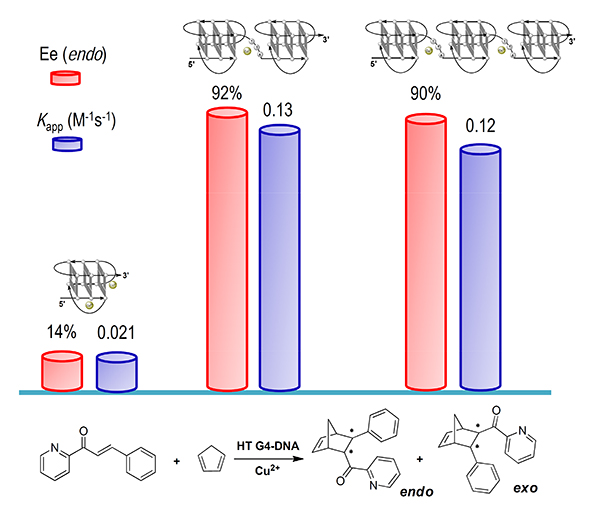Our group has made new progress in the field of DNA catalysis. In the Diels-Alder reaction catalyzed by human telomeric (HT) G-quadruplex DNA (G4-DNA) metalloenzyme, we found that more biologically relevant higher-order HT G4-DNA copper metalloenzymes (two or three G4 units) afford remarkably higher enantioselectivity (> 90% ee) and a five- to sixfold rate increase, compared to a single G4. This work has been recently published in the journal of ChemBioChem2015, 16, 618-624. Since the study of DNA catalysis was carried out by our group, this is first article published in a journal more emphasis on biology.
G4-DNA is one of DNA secondary structures folded by a guanine-rich DNA sequence. Research have reported that over 720000 DNA sequences may form G4 structures in the human genome. As related to cancer treatment, HT G4-DNA has received more attention among them. These studies are mainly concentrated in investigating the structural polymorphism of HT G4-DNA and in designing anticancer drugs to target specific G4 structures. Since 2009, our group has been committed to understanding the biological function of HT G4-DNA from the view point of DNA catalysis. We have found that: HT G4-DNA with one G4 unit can directly catalyze enantioselective carbon-carbon bond-forming reactions (Diels-Alder reaction: Angew. Chem. Int. Ed. 2012, 51, 9352-9355; Friedel-Crafts reaction: Chem. Commun. 2012, 48, 6232-6234); when combined with copper(II) ions to build HT G4-DNA metalloenzyme, the catalytic activity can be improved significantly. In particular, with tuning the ratio of Na+/K+ to transform the conformation of G4-DNA, the enantioselectivity of reaction can be switchable (Chem. Commun. 2013, 49, 11161-11163).
In this study, we further found that under physiological ionic condition (150 mM K+), more biologically relevant higher-order HT G4-DNA copper metalloenzyme (containing 2-3 G4 unit) can exhibit much higher catalytic activity than monomeric G4-DNA copper metalloenzyme. From the point of view of structure, our finding suggests that, like protein enzymes and ribozymes, the higher-order structural organization is crucial for G4-DNA-based catalysis. From the point of view of the biological function, this study further implies that the formation of G4-DNA in human telomere region may trigger some unexpected catalytic processes.
This work is financially supported by National Natural Science Foundation of China. (by Guoqing Jia and Yinghao Li)
